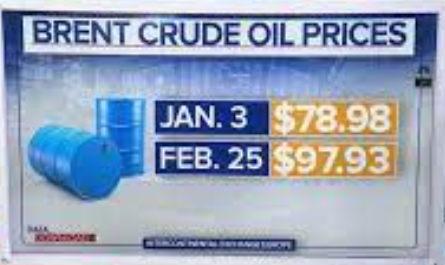How Russia’s invasion of Ukraine will impact the American economy
There are a wide range of possible impacts, but focusing on just three of them shows the potential for a very bumpy 2022.
By Dante Chinni
Russia’s invasion of Ukraine this week is not just an international story. It might have deep impacts within the United States as well, affecting economics and politics in an electorate that has started the year in a sour mood.
Last year should have sparked more joy among Americans. It was marked by big economic growth and low unemployment rates. But poll after poll shows Americans still feel the nation is struggling. And regardless of what’s driving those feelings of — such as rising inflation or the unending COVID-19 saga — that mindset has gotten ahold of much of the nation at the moment.
Now, the fallout from Russia’s incursion into Ukraine — and the economic sanctions that followed — has the potential to turn that dour American mood into something that looks more like anger as the 2022 midterms approach.
There are a wide range of possible impacts, but focusing on just three of them shows the potential for a very bumpy 2022.
Let’s start with an economic measure people frequently mention, the state of the Dow Jones Industrial Average. Voters often cite it as a broad measure of the state of their retirement accounts. That’s an over-simplification (retirement investments are usually more complicated than the state of one stock index), but psychologically, the DJIA numbers still matter to many Americans and the index may look unsettled for the near future.
Investors and businesses like stability. War and sanctions create the opposite scenario.
Even before this week’s invasion, the Dow had been in a slump and the Russia-Ukraine tensions has likely played some role. As of Friday’s close, the Dow was down 2,500 points, or 7 percent, compared to the beginning of the year. It was actually up from a crash on Thursday that immediately followed the invasion, but larger message seemed to be increased volatility.
Large amounts of uncertainty create hand-wringing when people check their retirement accounts and fret over the money they have “lost.” The story is more complicated than that, of course. Markets go up and down, and much of the wealth that was “lost” was really only theoretical. It was never truly held by the people looking at their online 401(k) statements.
Even with this year’s dip since January, the Dow is still up over where it was at the end of 2020 or the end of 2019. But ultimately, the DJIA is more of psychological measure of wealth for most Americans than a real one, and numbers that bounce up and down create consternation.
Other measures carry a little more real-world weight, however. Consider oil prices, which have already jumped since the Russian invasion of Ukraine.
Again, oil prices had been rising since the beginning of January, but the increases had been more dramatic in the last few weeks as the situation in Ukraine grew more intense. All told, the price of a barrel of oil has climbed 24 percent in the Brent Crude oil measure since the beginning of the year — from about $79 to nearly $100 at close of business Friday.
Rising gas prices hit the economy across the board and can have big inflationary effects over time. Merchandise has to be shipped. That means fuel for tankers, trains and trucks. If those prices stay high, costs are generally passed on to consumers.
On top of that, there is the pain at the pump that consumers feel when they fill the tanks of their cars and trucks. As the Data Download noted back in November, those increased costs tend to fall harder on rural communities where people often have to drive more and where they are more likely to own pickup trucks or other vehicles that are less fuel efficient. Those increases could fire up rural voters and bring them out to the polls in greater numbers.
And one other place Americans could feel the impact of the invasion is at the checkout line at the supermarket. Together, Russia and Ukraine account for roughly 29 percent of the world’s wheat export market and this week’s actions sent wheat prices climbing.
Again, the increase in prices on the commodity predate this week’s events in Ukraine, but the jump has accelerated since early February and there was a short, sharp spike on Thursday. By Friday evening, wheat future prices had settled in at more than $8.59 a bushel. That was up 13 percent from where the price was at the beginning of the year.
The United States imports very little wheat from Ukraine. In fact, the U.S. is a net exporter of wheat by a massive margin. But if/when global supplies shrink, prices rise and that can have impacts that reach around the world — even into your local market.
The Russian invasion of Ukraine is still very fresh and its real meaning and impact will unfold slowly, but, more important for 2022, the sanctions the United States and its allies have chosen as a response take time to work.
The real power of sanctions comes in the form of political pressure in the country facing sanctions. That takes time to build in any environment, but even longer in a country like Russia, with authoritarian leadership that is more immune to public opinion.
On Thursday, President Joe Biden announced the United States and its allies were stepping up sanctions against Russia and said the Ukrainian people are likely in line for several difficult weeks and months. That timeline suggests any economic disruptions from Russian invasion are going to be with us a while. And an already surly electorate is going to have plenty of reasons to be in a fouler mood in the months ahead.

